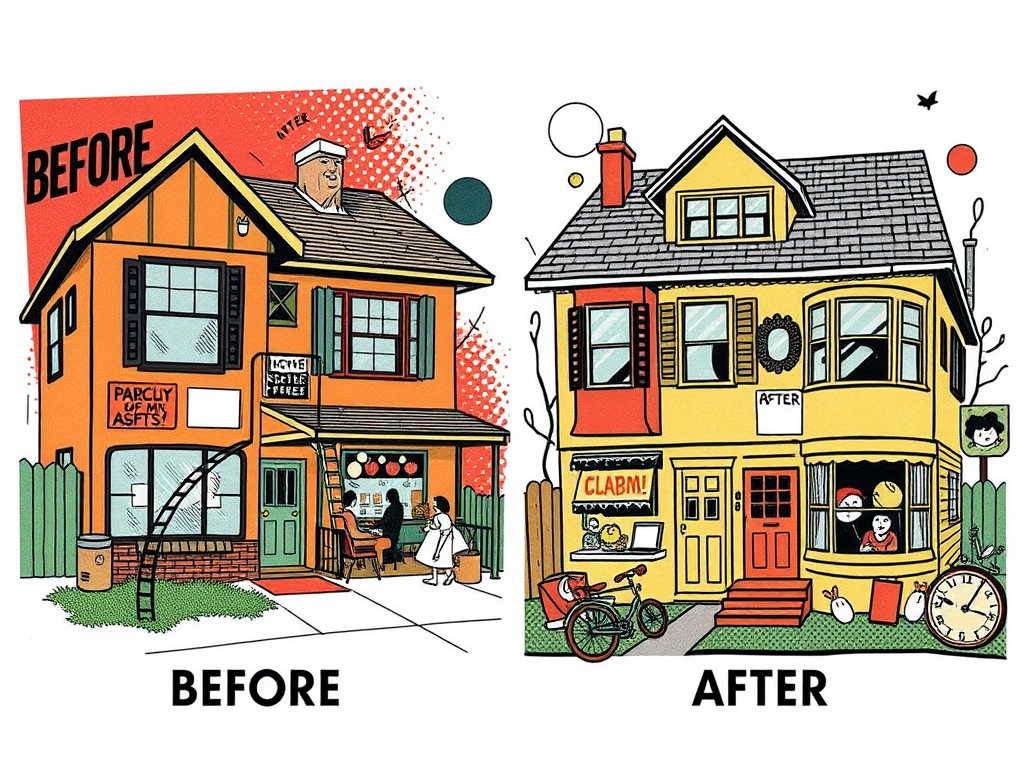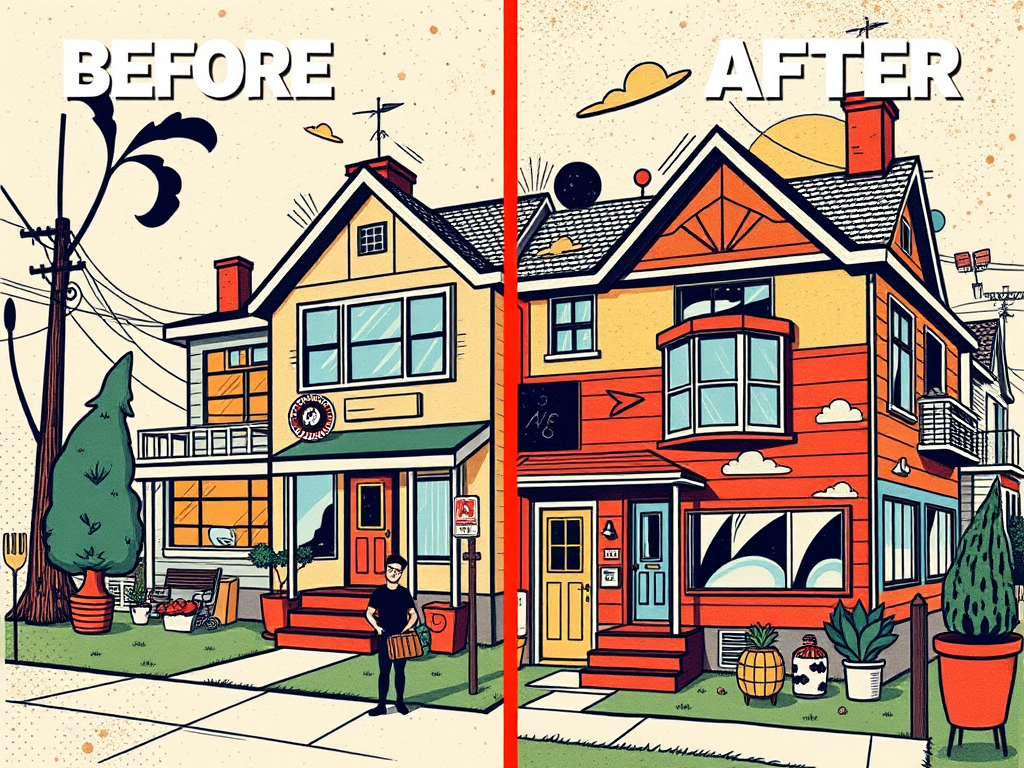
Property Flipping Case Study: A Successful Renovation and Sale in Crete
Reading time: 15 minutes
Table of Contents
- Introduction
- The Property: Overview and Initial Assessment
- Market Analysis: Crete’s Real Estate Landscape
- Renovation Process and Challenges
- Marketing and Sale Strategy
- Financial Breakdown
- Lessons Learned and Key Takeaways
- Conclusion
- FAQs
Introduction
In the ever-evolving world of real estate investment, property flipping remains a popular strategy for those looking to capitalize on market inefficiencies and create value through renovation. This case study delves into a successful property flip on the picturesque island of Crete, Greece, offering valuable insights into the process, challenges, and outcomes of such an investment venture.
As we explore this case study, we’ll examine the various factors that contributed to its success, from initial property selection to the final sale. This comprehensive analysis will provide aspiring investors and real estate professionals with a detailed roadmap for executing similar projects, while also highlighting the unique aspects of the Greek property market.
The Property: Overview and Initial Assessment
Our subject property is a charming 120 square meter villa located in the coastal town of Chania, Crete. Built in the 1980s, the property boasted stunning sea views but had fallen into a state of disrepair due to years of neglect. Here’s a breakdown of the property’s initial characteristics:
- Location: 2 km from Chania’s historic old town
- Plot size: 400 square meters
- Building size: 120 square meters
- Layout: 3 bedrooms, 2 bathrooms, open-plan living area
- Outdoor features: Small garden, terrace with sea view
- Condition: Poor, requiring extensive renovation
- Purchase price: €180,000
The initial assessment revealed several critical issues that needed addressing:
- Structural integrity concerns, particularly in the roof and foundation
- Outdated electrical and plumbing systems
- Inefficient layout that didn’t maximize the property’s potential
- Worn-out finishes and fixtures throughout the interior
- Neglected exterior spaces, including the garden and terrace
Despite these challenges, the property’s location and inherent charm made it an attractive candidate for renovation and resale. The stunning sea views and proximity to Chania’s popular old town were key factors in the decision to pursue this investment opportunity.
Market Analysis: Crete’s Real Estate Landscape
Before diving into the renovation process, it’s crucial to understand the broader context of Crete’s real estate market. This analysis informed our investment strategy and helped set realistic expectations for the project’s potential returns.
Key Market Indicators
- Tourism growth: Crete has experienced steady growth in tourist arrivals, driving demand for holiday homes and rental properties.
- Foreign investment: Increasing interest from international buyers, particularly from Northern Europe and North America.
- Price trends: Gradual appreciation in property values, with coastal areas showing the strongest growth.
- Supply and demand: Limited inventory of high-quality, renovated properties in prime locations.
- Regulatory environment: Relatively favorable conditions for foreign property ownership, with some restrictions on certain coastal and border areas.
Our analysis revealed a growing demand for turn-key properties that offer modern amenities while retaining traditional Cretan charm. This insight guided our renovation strategy, aiming to create a property that would appeal to both the local market and international buyers seeking a Mediterranean retreat.
Renovation Process and Challenges
The renovation process spanned six months and involved a comprehensive overhaul of the property. Here’s a detailed breakdown of the key phases and challenges encountered:
1. Structural Repairs
The first and most critical phase involved addressing the structural issues identified during the initial assessment. This included:
- Reinforcing the foundation to ensure long-term stability
- Replacing the entire roof structure and installing new waterproofing
- Repairing and reinforcing load-bearing walls
Challenge: During the foundation work, we discovered unexpected rock formations that required specialized equipment and expertise to address properly. This led to a two-week delay and a 10% increase in the structural repair budget.
2. Systems Upgrade
Modernizing the property’s core systems was essential to meet current standards and improve overall efficiency:
- Complete rewiring of the electrical system
- Installation of new plumbing, including water-saving fixtures
- Implementation of a modern HVAC system for year-round comfort
- Integration of smart home features for lighting, security, and climate control
Challenge: The integration of smart home technology presented compatibility issues with some of the existing systems. We had to bring in a specialized technician to ensure seamless operation, adding to the project’s cost and timeline.
3. Layout Optimization
To maximize the property’s potential and appeal to a broad range of buyers, we made several layout changes:
- Opened up the living area to create a more spacious, open-plan design
- Converted one bedroom into a home office/guest room with en-suite bathroom
- Expanded the master bedroom to include a walk-in closet and private terrace
- Redesigned the kitchen to incorporate a central island and dining area
Challenge: The layout changes required obtaining additional permits from local authorities, which took longer than anticipated. This resulted in a three-week delay to the overall project timeline.
4. Interior Finishes and Fixtures
Selecting high-quality finishes and fixtures was crucial to achieving the desired aesthetic and functionality:
- Installation of premium tile and hardwood flooring throughout
- Custom-built kitchen cabinets and stone countertops
- High-end bathroom fixtures and fittings
- Bespoke wooden doors and windows to enhance energy efficiency
- Fresh paint in a neutral color palette to appeal to a wide range of tastes
Challenge: Sourcing certain materials proved difficult due to supply chain disruptions. We had to adapt our design choices in some areas to avoid further delays, balancing aesthetics with practicality.
5. Exterior Improvements
Enhancing the property’s curb appeal and outdoor living spaces was essential to maximizing its value:
- Landscaping the garden with drought-resistant Mediterranean plants
- Installing an infinity pool overlooking the sea
- Creating an outdoor kitchen and dining area on the main terrace
- Refurbishing the exterior façade with traditional Cretan stonework
Challenge: The installation of the infinity pool required additional engineering work to ensure proper drainage and structural support. This led to a 15% increase in the exterior improvement budget.
Marketing and Sale Strategy
With the renovation complete, our focus shifted to effectively marketing and selling the property. Our strategy encompassed several key elements:
1. Professional Photography and Virtual Tours
We invested in high-quality professional photography and created immersive virtual tours to showcase the property’s stunning features and breathtaking views. These assets were crucial in attracting international buyers who couldn’t easily visit the property in person.
2. Multi-Channel Marketing
Our marketing efforts included:
- Listings on major international real estate portals
- Partnerships with local and international real estate agencies
- Targeted social media advertising campaigns
- Features in luxury lifestyle and travel magazines
3. Pricing Strategy
We positioned the property at the upper end of the local market, reflecting its premium features and unique location. The initial listing price was set at €750,000, with room for negotiation.
4. Exclusive Viewings and Events
We organized a series of exclusive viewings and events for potential buyers, including:
- Sunset cocktail receptions on the terrace
- Private dinners prepared by a local chef in the outdoor kitchen
- Guided tours of Chania’s old town for interested parties
These events helped create an emotional connection with the property and showcase its potential as both a private residence and a lucrative vacation rental.
Financial Breakdown
Here’s a detailed breakdown of the financial aspects of this property flip:
| Category | Amount (€) |
|---|---|
| Purchase Price | 180,000 |
| Renovation Costs | 320,000 |
| Marketing and Sales | 25,000 |
| Legal and Administrative Fees | 15,000 |
| Financing Costs | 30,000 |
| Total Investment | 570,000 |
| Sale Price | 785,000 |
| Gross Profit | 215,000 |
| Return on Investment (ROI) | 37.7% |
The property sold after 45 days on the market for €785,000, slightly above our initial listing price. This resulted in a gross profit of €215,000 and a return on investment (ROI) of 37.7%.
Lessons Learned and Key Takeaways
This successful property flip in Crete provided several valuable insights for future projects:
- Thorough due diligence is crucial: Our initial assessment missed some structural issues, highlighting the importance of comprehensive inspections.
- Flexibility in renovation plans: Being able to adapt to unexpected challenges and market demands is essential for success.
- Local partnerships matter: Building strong relationships with local contractors, suppliers, and real estate agents was instrumental in navigating challenges and achieving a successful sale.
- High-end finishes pay off: The investment in premium materials and fixtures significantly contributed to the property’s final value and appeal to buyers.
- Marketing is key: A well-executed marketing strategy, including professional photography and targeted campaigns, played a crucial role in attracting the right buyers.
- Understanding the local market: Our success was partly due to recognizing the growing demand for turn-key properties that blend modern amenities with traditional charm.
- Patience in pricing: Setting a slightly higher initial listing price allowed room for negotiation while still achieving a strong sale price.
Conclusion
This case study demonstrates the potential for significant returns in the Greek property market through strategic renovation and marketing. The success of this project in Crete underscores the importance of thorough market analysis, adaptability in the face of challenges, and a comprehensive approach to property improvement and marketing.
While the financial returns were impressive, it’s important to note that such results are not guaranteed in every property flip. The unique combination of location, market conditions, and execution contributed to this project’s success. Investors considering similar ventures should conduct thorough due diligence and be prepared for the complexities inherent in international real estate investments.
As the Greek property market continues to evolve, opportunities for value creation through renovation and resale are likely to persist. However, success will increasingly depend on a deep understanding of local market dynamics, strong partnerships, and the ability to deliver properties that meet the evolving preferences of both local and international buyers.
For those interested in exploring similar opportunities in Greece, consider investigating property for sale in peloponnese, another region known for its beautiful coastlines and investment potential.
FAQs
1. What are the main challenges of flipping properties in Greece?
The main challenges include navigating local regulations and permits, managing potential language barriers, understanding the nuances of the Greek real estate market, and dealing with potential supply chain issues for construction materials.
2. How long does a typical property flip take in Greece?
The duration can vary significantly depending on the property’s condition and the extent of renovations required. On average, a comprehensive flip like the one in this case study can take 6-12 months from purchase to sale.
3. Are there any restrictions on foreign property ownership in Greece?
While Greece generally welcomes foreign property investment, there are some restrictions on purchases in certain border areas and some islands. It’s crucial to work with a local legal expert to navigate these regulations.
4. What types of properties offer the best potential for flipping in Greece?
Properties in popular tourist destinations, especially those with unique features like sea views or historical significance, often offer good potential. However, the specific opportunities can vary depending on current market trends and local demand.
5. How has the COVID-19 pandemic affected the property flipping market in Greece?
The pandemic initially caused some market uncertainty, but it has also increased interest in second homes and remote work-friendly properties in Greece. This has created new opportunities for investors who can cater to these evolving preferences.

Article reviewed by Enzo Almeida, Business Scaling Expert | Growth Strategist | Driving Expansion in Emerging Markets, on March 19, 2025
